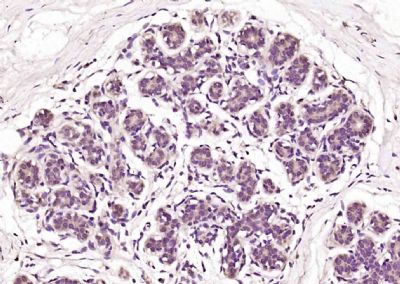HSP20 Polyclonal Antibody
Purified Rabbit Polyclonal Antibody (Pab)
- SPECIFICATION
- CITATIONS
- PROTOCOLS
- BACKGROUND

Application
| IHC-P, IHC-F, IF, E |
|---|---|
| Primary Accession | O14558 |
| Reactivity | Rat, Dog, Bovine |
| Host | Rabbit |
| Clonality | Polyclonal |
| Calculated MW | 17 KDa |
| Physical State | Liquid |
| Immunogen | KLH conjugated synthetic peptide derived from human HSPB6 |
| Epitope Specificity | 6-80/160 |
| Isotype | IgG |
| Purity | affinity purified by Protein A |
| Buffer | 0.01M TBS (pH7.4) with 1% BSA, 0.02% Proclin300 and 50% Glycerol. |
| SUBCELLULAR LOCATION | Cytoplasm. Nucleus. Note=Translocates to nuclear foci during heat shock. |
| SIMILARITY | Belongs to the small heat shock protein (HSP20) family. |
| SUBUNIT | Homodimer (By similarity). |
| Post-translational modifications | The N-terminus is blocked. |
| Important Note | This product as supplied is intended for research use only, not for use in human, therapeutic or diagnostic applications. |
| Background Descriptions | Hsp20 is a small heat shock protein related to Hsp25, Hsp27 and may form different hetercomplexes with these proteins. The specific physiological function of Hsp20 is not yet known. It is distributed ubiquitously in tissues, but is found in higher levels in skeletal, smooth and heart muscle. Under normal conditions, Hsp20 is diffusely distributed in the cytosol, but under heat stress conditions, it translocates to the nucleus. Unlike other heat shock proteins the amount of Hsp20 does not increase after heat shock. The Hsp20 was demonstrated to constitute up to 1.3% of the total cellular protein in vertebrate tissues, especially in muscle, and its expression is related to muscle contraction, specifically in slow-twitch muscle. Hsp20 may form different heterocomplexes with other Hsp's, such as alpha-crystalline and Hsp25. Phosphorylated form of Hsp20 is proposed to interact with monomeric actin whereas dephosphorylated form binds polymeric actin filaments. In normal conditions Hsp20 is diffusely disturbed in cytosol but under the heat stress it undergoes translocation to membrane fraction. |
| Gene ID | 126393 |
|---|---|
| Other Names | Heat shock protein beta-6, HspB6, Heat shock 20 kDa-like protein p20, HSPB6 |
| Dilution | IHC-P=1:100-500,IHC-F=1:100-500,IF=1:100-500,ELISA=1:5000-10000 |
| Storage | Store at -20 ℃ for one year. Avoid repeated freeze/thaw cycles. When reconstituted in sterile pH 7.4 0.01M PBS or diluent of antibody the antibody is stable for at least two weeks at 2-4 ℃. |
| Name | HSPB6 |
|---|---|
| Function | Small heat shock protein which functions as a molecular chaperone probably maintaining denatured proteins in a folding- competent state. Seems to have versatile functions in various biological processes. Plays a role in regulating muscle function such as smooth muscle vasorelaxation and cardiac myocyte contractility. May regulate myocardial angiogenesis implicating KDR. Overexpression mediates cardioprotection and angiogenesis after induced damage. Stabilizes monomeric YWHAZ thereby supporting YWHAZ chaperone-like activity. |
| Cellular Location | Cytoplasm. Nucleus. Secreted Note=Translocates to nuclear foci during heat shock |

Thousands of laboratories across the world have published research that depended on the performance of antibodies from Abcepta to advance their research. Check out links to articles that cite our products in major peer-reviewed journals, organized by research category.
info@abcepta.com, and receive a free "I Love Antibodies" mug.
Provided below are standard protocols that you may find useful for product applications.
If you have used an Abcepta product and would like to share how it has performed, please click on the "Submit Review" button and provide the requested information. Our staff will examine and post your review and contact you if needed.
If you have any additional inquiries please email technical services at tech@abcepta.com.













 Foundational characteristics of cancer include proliferation, angiogenesis, migration, evasion of apoptosis, and cellular immortality. Find key markers for these cellular processes and antibodies to detect them.
Foundational characteristics of cancer include proliferation, angiogenesis, migration, evasion of apoptosis, and cellular immortality. Find key markers for these cellular processes and antibodies to detect them. The SUMOplot™ Analysis Program predicts and scores sumoylation sites in your protein. SUMOylation is a post-translational modification involved in various cellular processes, such as nuclear-cytosolic transport, transcriptional regulation, apoptosis, protein stability, response to stress, and progression through the cell cycle.
The SUMOplot™ Analysis Program predicts and scores sumoylation sites in your protein. SUMOylation is a post-translational modification involved in various cellular processes, such as nuclear-cytosolic transport, transcriptional regulation, apoptosis, protein stability, response to stress, and progression through the cell cycle. The Autophagy Receptor Motif Plotter predicts and scores autophagy receptor binding sites in your protein. Identifying proteins connected to this pathway is critical to understanding the role of autophagy in physiological as well as pathological processes such as development, differentiation, neurodegenerative diseases, stress, infection, and cancer.
The Autophagy Receptor Motif Plotter predicts and scores autophagy receptor binding sites in your protein. Identifying proteins connected to this pathway is critical to understanding the role of autophagy in physiological as well as pathological processes such as development, differentiation, neurodegenerative diseases, stress, infection, and cancer.


